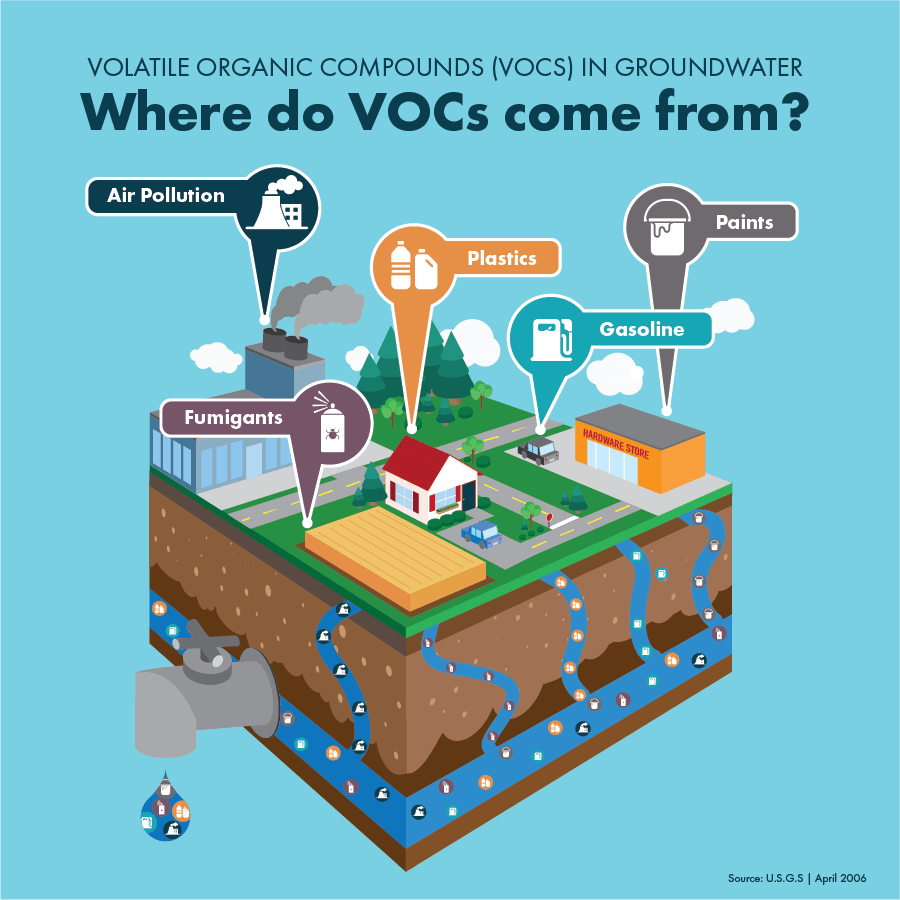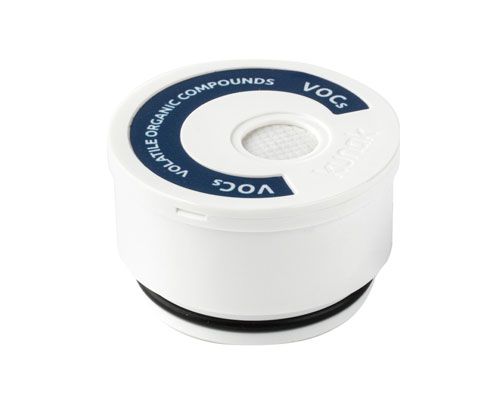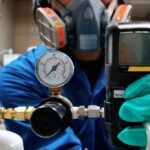Volatile Organic Compounds (VOCs) are chemical substances primarily composed of carbon and hydrogen, but they can also contain other elements such as oxygen, nitrogen, sulphur, or halogens (fluorine, chlorine, bromine). Their “superpower” is that they are highly volatile, meaning they easily evaporate and become gases at room temperature. While some VOCs are harmless, others can be quite dangerous. When released into the atmosphere, they react with other pollutants and contribute to the formation of smogSmog, beyond that dense fog
Smog is a mixture of air pollutantsAir pollution caused by atmospheric contaminants is one of the most critical and complex environmental problems we face today, both because of its global r...
Read more that accumulate in the atmosphere, especially in urban areas. This phenomenon is character...
Read more or harmful particles, worsening air qualityAir quality refers to the state of the air we breathe and its composition in terms of pollutants present in the atmosphere. It is considered good when poll...
Read more. Additionally, some are toxic and can seriously affect health, causing respiratory problems, irritations, or even more severe illnesses such as cancer.
What are volatile organic compounds (VOCs)?
Definition and characteristics
Volatile Organic Compounds (VOCs) are a large family of more than a thousand chemical substances. They share a common structure based on carbon chains, typically with fewer than 12 atoms. Most are hydrocarbons (compounds of carbon and hydrogen) or their derivatives.
Their most notable characteristic is that they are extremely volatile substances and can easily become gas from a liquid or solid state, even at room temperature. This makes them commonly escape into the air we breathe. They are also highly reactive when they come into contact with other substances in the atmosphere, triggering chemical reactions that generate hazardous pollutants such as tropospheric ozoneTropospheric ozone (O3) or ground-level ozone is a gas found in the lowest layer of the Earth's atmosphere, the troposphere, which extends up to 10 kilomet...
Read more and photochemical smog.
Common examples of VOCs
Among the most common and abundant VOCs in the air are:
- Benzene: Colourless and highly flammable, it is one of the most widely used chemical solvents as an initial or intermediate product in industrial and pharmaceutical processes. Its atmospheric presence mainly comes from tobacco smoke, vehicle emissions (found in crude oil and petrol), and industry.
- Formaldehyde: Although colourless and highly flammable at room temperature, it is recognised by its characteristic pungent odour. It is a basic substance in the chemical industry and is often found in building materials, furniture, and cleaning products.
- Toluene: A VOC that originates from benzene. In liquid state, it is insoluble in water, transparent, and colourless with a characteristic smell. It is generated by tobacco smoke and in the production of fuels like petrol, where it is added as an anti-knock agent. It is used in the production of paints, varnishes, dyes, detergents, aromatic products, adhesives, and is essential for synthesising the explosive TNT.
- Xylene: With a smell similar to toluene, it is also a VOC that is colourless and flammable. It is mainly used as a solvent, cleaner, and to thin paints and varnishes, in printing processes, and during the manufacture of rubber and leather.
- Styrene: A VOC generated from the combination of benzene and ethylene that is essential for the chemical industry during the manufacture of rubber, plastics, insulating materials, food packaging, pipes, and certain car parts.
Other VOCs commonly used in industrial processes include methane (potent greenhouse gas), n-butane (liquefied under atmospheric pressure and part of fuels and aerosols), i-pentane or isopentane and n-pentane or pentane (indispensable in the petrochemical industry), ethane (from natural gas and petroleum emissions), propane (used as a domestic and industrial fuel), and ethylene (for industrial production of plastics and chemicals).
Air Quality Innovation in Just 1 Click
Stay informed about the air you breathe!
Subscribe to our newsletter to receive the latest updates on environmental monitoring technology, air quality studies, and more.
Differences between primary and secondary VOCs
- Primary VOCs: These are directly emitted into the atmosphere from a source, whether natural or anthropogenic. Their emission usually comes from industrial processes, combustion vehicles, household chemicals, and natural sources such as vegetation and wildfires. Examples include benzene, toluene, xylene, isoprene, xylene, and formaldehyde.
- Secondary VOCs: They are formed in the atmosphere due to chemical reactions between primary VOCs and other pollutants present in the air, such as nitrogen oxides (NOx), with sunlight acting as a catalyst. This leads to hazardous VOCs such as tropospheric ozone.
Sources of volatile organic compounds in the air
Emission sources of VOCs can be distinguished depending on whether they originate from natural phenomena or anthropogenic activities:
Natural sources
- Vegetation: Plants emit VOCs such as isoprene and monoterpenes, which can contribute to the formation of tropospheric ozone.
- Wildfires: Biomass combustion releases large amounts of VOCs, including benzene, formaldehyde, and toluene.
Anthropogenic sources
- Traffic: Exhaust gases from cars and heavy vehicles contain numerous VOCs, such as benzene and toluene.
- Industry: The production of certain chemicals, plastics, and fuels releases VOCs into the environment. Petroleum refineries emit large quantities of VOCs into the air during fuel production and processing. The electronics and textile industries generate VOC emissions due to the use of adhesives, inks, and industrial solvents.
- Household Products: Paints, solvents, cleaning products, and aerosols contain VOCs that are released both indoors and outdoors.
Effects of volatile organic compounds on health and the environment
Impact of VOCs on human health
Exposure to VOCs can cause adverse health effects, depending on the type of compound, concentration present in the air, and duration of exposure. Some of the most common impacts include eye, nose, and throat irritation, headaches, and dizziness with narcotic effects. They can also cause respiratory difficulties and worsen conditions such as asthma. Among the most harmful chronic effects are liver and kidney damage or alterations in the central nervous system. Some VOCs (such as benzene and formaldehyde) are linked to cancer development.
Contribution of VOCs to environmental pollution and climate change
VOCs have a significant impact on the environment due to their high chemical reactivity and ease of dispersion in the atmosphere. This results in:
- Formation of tropospheric ozone: A key component of photochemical smog that affects air quality and human health.
- Contribution to climate change: While not all VOCs have a direct impact on global warming, some, like methane, are potent greenhouse gasesWhile the concentration of carbon dioxide (CO2) in the atmosphere has been steadily and rapidly increasing in recent decades, in May 2025, CO2 surpassed 43...
Read more. - Water and soil contamination: Some VOCs can infiltrate water bodies or soils, affecting water quality and damaging aquatic and terrestrial ecosystems.
- Damage to vegetation: Prolonged exposure to high levels of VOCs can damage plants, reducing photosynthesis, affecting crop growth, and degrading natural vegetation.
Given their significant impact on health and the environment, it is essential to reduce VOC emissions by using products with low VOC content. In processes where VOCs are indispensable, it is crucial to constantly monitor their presence in the air in real time to act quickly and detect their presence, preventing ecological and public health damage.
Regulations on volatile organic compounds: Limits and legislation
VOCs regulations vary significantly worldwide, as each country or region establishes its own environmental, industrial, and public health priorities. However, despite the lack of uniformity, there are widespread international efforts to reduce VOC emissions, leading to a gradual convergence towards stricter standards, especially in developing countries.
Below are the most significant regulatory actions.
- The EU has some of the strictest and most advanced regulations on VOCs, governed by various directives. It sets maximum VOC values for different product categories, with periodic reviews to adapt to technological and scientific advancements. Key regulatory measures include:
- Directive 2010/75/EU: Establishes standards for industrial emissions, including VOCs.
- Directive 2004/42/EC: Limits VOC emissions in paints, varnishes, and vehicle coating products.
- Directive 1999/13/EC: Controls VOC emissions as organic solvents in industrial activities and installations.
- REACH Regulation: Manages the manufacture or import of chemical substances, including VOCs.
- In the United States, the regulatory system is robust but varies at federal and state levels. VOC limits are higher than in the EU; however, in California, there are even stricter limits than European standards. VOC regulations are governed by:
- Clean Air Act: Regulates VOC emissions at the federal level.
- EPA (Environmental Protection Agency): Sets standards for certain chemicals, such as paints, adhesives, and fuels.
- California Air Resources Board (CARB): Establishes stricter regulations than the rest of the country, especially for consumer products and industrial emissions.
Both the World Health Organization (WHO) and the European Environment Agency (EEA) agree on the need to reduce VOC emissions to protect human health and the environment. While they do not set specific limits for VOCs in products such as paints or varnishes, they provide guidelines and recommendations on air quality, reference values, and pollutant exposure limits, including VOCs. The WHO’s recommendations are based on health effects through epidemiological and toxicological studies to reduce adverse health effects and minimize the risk of diseases such as cancer.
The EEA develops recommendations aligned with EU criteria. It also monitors and reports air quality data in Europe, including the presence of VOCs, to assess compliance with EU regulations. Although it does not set its own limits, it works in coordination with the European Commission to implement policies that reduce VOC emissions.
How VOC measurement and monitoring is performed
Volatile organic compounds sensors: Current technologies
VOC sensors are devices used to detect and measure the concentration of these compounds in the air. There are several available technologies, each with its own advantages and limitations:
- Adsorption Tubes: Using an adsorbent material such as activated carbon or silica, they capture VOCs from the air. Sample analysis is carried out in laboratories through gas chromatography. They offer high precision and sensitivity, making them the appropriate method for specific spot measurements, but they do not provide real-time data. Moreover, it is a slow and costly method due to laboratory analysis.
- Gas Chromatography: A widely used analytical technique in chemistry to study complex mixtures of volatile or semi-volatile substances like VOCs. It requires analytical techniques that function like a miniature laboratory, separating components of the gaseous or vaporised mixture to measure each compound’s concentration. It provides high precision and capacity to identify multiple VOCs but is a costly system without the possibility of sending real-time data.
- Photoionisation Detectors (PID): They use ultraviolet (UV) light to ionise VOCs. The ionised compounds generate an electric current proportional to their concentration. The measurement is converted into a concentration reading. They are highly sensitive to a wide range of VOCs and can be used portably; however, they do not differentiate between different VOC types and are sensitive to humidity and the presence of other gases.
- Electrochemical Sensors: Measure changes in electrical properties when VOCs interact with an electrolyte. The current is measured and converted into a reading. This method is portable and suitable for continuous monitoring, but less sensitive than PID sensors and also prone to interference from other atmospheric gases.
- Metal Oxide Sensors (MOS): Use a semiconductor material (such as tin or zinc oxide) that changes its electrical resistance when interacting with VOCs. Adsorption alters the material’s conductivity, which is measured and correlated with VOC concentration. They are cheap, portable, and operate in real-time. However, they lack high gas selectivity, and their measurements can be affected by temperature and humidity.
Advanced solutions for continuous VOC monitoring
Advanced VOC monitoring solutions combine innovative sensor-based technologies with data transmission systems and cloud-based analysis platforms, like Kunak’s comprehensive solutions, which measure and manage data in real-time.
To achieve this, we offer:
- Monitoring with Kunak AIR Stations: Advanced devices designed for the continuous and real-time measurement of atmospheric pollutants (such as NO₂, O₃, PM particles, etc.), including VOCs. The robust and portable stations allow the integration of different sensors according to the specific needs of the user or project.
While the Kunak AIR Pro station is designed for professional applications across various environments requiring the monitoring of multiple pollutants, the Kunak AIR Lite version features a more lightweight and compact design, ideal for applications where measuring no more than two pollutants and particles is sufficient. Both stations transmit real-time data via wireless connections and require low maintenance, making them easy to operate in different environmental conditions with minimal intervention.
Both stations monitor air quality in cities, industrial zones, or areas sensitive to atmospheric pollution. They help comply with environmental regulations in the region and country, providing the appropriate data to develop environmental impact studies and protect public health.
- VOC Cartridge: Specific cartridges that offer flexibility and precision in VOC measurement. They are easy to install and interchangeable, allowing stations to adapt to different needs. Designed to integrate with AIR Pro and AIR Lite stations.
They use optimised electrochemical or MOS sensors to detect VOCs and can be configured to measure specific VOCs (such as benzene, toluene, or xylene). Their calibration includes algorithms to compensate for interference from other gases and environmental conditions like humidity and temperature.
These cartridges provide greater VOC measurement accuracy, flexibility to adapt to various environments and applications, and cost reduction by allowing the station to be reused with different cartridges for other projects.
- Kunak AIR Cloud Platform: A cloud-based platform that enables the analysis of data collected by Kunak AIR Pro and AIR Lite stations, as well as the remote management of each device in the network. By analysing the data, it provides graphs, maps, and reports to facilitate interpretation, enabling informed decision-making. Additionally, it configures automatic alerts when predefined VOC or other pollutant thresholds are exceeded, allowing for rapid and effective action.
This platform can integrate other systems or third-party information. The collected data analysis enables the detection of trends and long-term assessments that improve efficiency and facilitate informed decision-making.
In summary, Kunak’s advanced solutions are revolutionary by combining technology into a system that merges robustness, precision, and versatility. Specifically, for continuous VOC monitoring, they combine hardware designed to withstand the most demanding conditions, a wide range of specific sensors, and a cloud-based platform that provides real-time data access, offering an integrated system.
These tools are essential wherever precision, flexibility, and real-time analysis are required, such as environmental monitoring, industrial management, or public health protection.
Why VOC monitoring is crucial in urban and industrial environments
The air quality we breathe affects us all, but in urban and industrial environments, the presence of VOCs can become an invisible and dangerous problem. These compounds, released by industrial activities, vehicles, chemicals, and even building materials, not only pollute the air but can also have serious effects on human health and the environment. Therefore, VOC monitoring has become an essential tool to ensure safety and wellbeing in these environments.
The key areas to control their emissions include:
- Monitoring in Industrial Areas and Refineries: These are critical hotspots for VOC emissions where substances such as benzene, toluene, or xylene are commonly released, posing a high risk even at low concentrations. The lack of continuous monitoring can result in VOC emissions reaching dangerous levels, releasing toxic compounds like benzene, a carcinogenic substance that can affect refinery and chemical plant workers as well as nearby residents.
Ensuring health and safety in industrial plants is essential when operating with substances that pose potential risks to workers and surrounding communities. This is the case with LIFECO, a leading fertiliser producer in Libya, which has deployed a monitoring solution that meets high precision standards while operating continuously and autonomously in a demanding industrial environment, where it monitors a variety of gases and particles, including VOCs.
- Worker Protection in Solvent Emission Environments: In industries such as painting, printing, or chemical manufacturing, workers are exposed to solvents containing VOCs. Compounds like formaldehyde or styrene can cause short- and long-term health problems, ranging from respiratory irritation to chronic illnesses. Continuous VOC monitoring in these environments not only ensures compliance with occupational safety regulations but also protects workers’ health.
- Indoor Air Quality Control: Indoor air can be up to five times more polluted by VOCs than outdoor air. It is crucial to monitor these chemical substances present in building materials, furniture, cleaning products, and even air fresheners. Compounds like formaldehyde or trichloroethylene can accumulate in enclosed spaces, affecting the health of those who live and work there.
Conclusion: The importance of effective VOC monitoring
VOC monitoring in urban and industrial environments is not just a matter of regulatory compliance; it is an essential technical tool that combines precision, reliability, and speed to protect people’s health, prevent toxic incidents, and improve the quality of the air we breathe.
With advanced solutions like those offered by Kunak (AIR Pro and AIR Lite), it is possible to radically transform the way we manage these risks, offering accurate, reliable, and real-time data. This not only facilitates the early detection of hazardous emissions but also enables informed and agile decision-making, optimising processes, and reducing environmental impacts.
In a world where air pollution is one of the greatest global challenges, Kunak’s technology positions itself as an ally in building a safer and more sustainable future. By promoting operational efficiency and adherence to the highest quality standards, Kunak’s technology not only protects people and the environment but also fosters industrial commitment to a healthier world.
FAQs about volatile organic compounds
How do volatile organic compounds affect health?
Volatile organic compounds (VOCs), as highly volatile chemical substances, easily evaporate at room temperature and disperse into the air we breathe. They are invisible and a dangerous influence on our health. Even at low concentrations and short exposure times, they can cause temporary effects such as eye, nose, and throat irritation, headaches, dizziness, nausea, fatigue, and breathing difficulties. Prolonged exposure to VOCs is linked to severe health damage in individuals with pre-existing respiratory conditions such as asthma or chronic obstructive pulmonary disease (COPD). Some VOCs, due to their carcinogenic effects, can contribute to the development of leukaemia, lung, or liver cancer. They can also cause liver and kidney damage.
What are the main sources of VOCs at home and in industry?
The impact of pollutants like VOCs is significant both at home and in industry. VOC sources are present in many aspects of our daily lives, from the products we use at home to the most complex industrial processes. VOCs are chemicals released into the air as gases and can have negative effects on health and the environment, especially when they accumulate in poorly ventilated indoor spaces.
VOCs are all around us, from household cleaning and disinfecting products to paints and varnishes covering our furniture or curtain and carpet textiles. They are present in building materials, air fresheners, and scented candles. Gas stoves, fireplaces, and heaters are also sources of VOC emissions at home, as well as printers and photocopiers.
In industry, VOC sources come from specific processes in oil refineries and natural gas processing, plastics, resins, and organic chemical production, vehicle coatings, printing, pharmaceuticals, footwear, and textiles, as well as cleaning and degreasing processes in industrial facilities.
Knowing these sources is the first step to reducing their impact and protecting our health and the environment. Choose VOC-free or low-VOC products for your home, ventilate indoor spaces well, especially after using chemical products, and use indoor plants that purify the air. In industry, continuous air monitoring is essential to detect VOC emissions, along with technology to capture and treat emissions when they occur.
How is VOC concentration measured?
Measuring VOC concentration is essential to protect human health and the environment. From laboratory methods to portable solutions providing real-time measurements, measuring VOC concentration is a technical process requiring specific tools and methods, depending on the environment (indoor, outdoor, or industrial) and the VOCs to be detected. Techniques include gas chromatography, mass spectrometry, electrochemical and photoionisation sensors (PID), adsorption tubes, and real-time VOC monitors.
What solutions exist for real-time VOC monitoring?
The use of advanced sensors to measure VOC concentration enables continuous and real-time monitoring. The collected data is transmitted to a cloud platform for analysis and visualisation. The greatest advantage of these systems is their continuous monitoring capability, portability, and the ability to cover large areas offered by these environmental monitoring networks, for industrial control and public health protection.
What is the safe limit of VOCs in the air according to the WHO?
The World Health Organisation (WHO) does not set a universal safe limit for all volatile organic compounds, as these chemical substances are highly diverse and each has different health effects. However, the WHO and other organisations such as the European Union and the United States Environmental Protection Agency (EPA) have issued recommendations and guidelines for specific VOCs like benzene, formaldehyde, toluene, and xylene.






